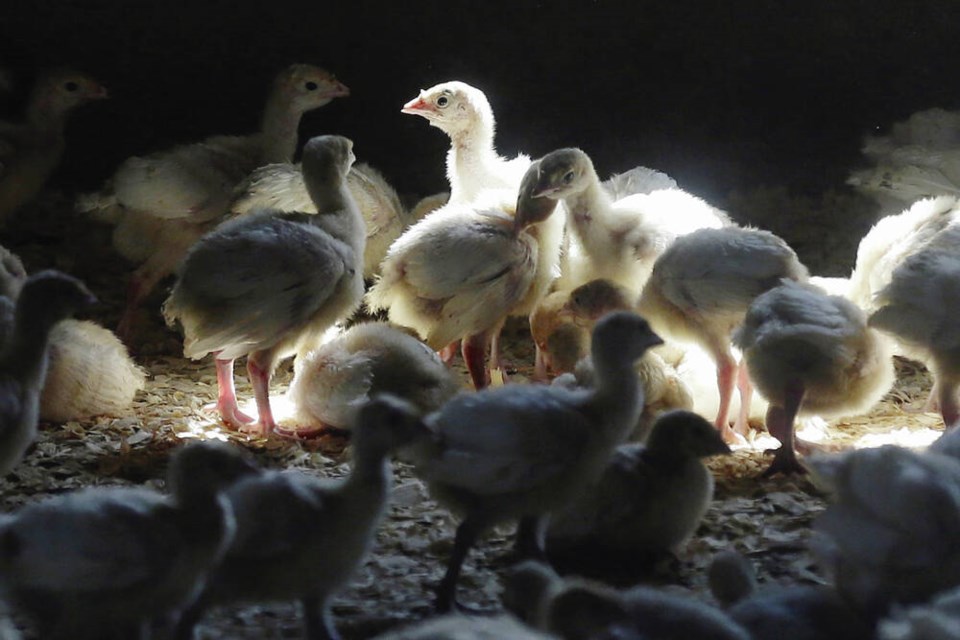Canadians may be learning to live with COVID, but poultry farmers and wildlife officials are dealing with a new and different pandemic — highly pathenogenic avian influenza.
According to the Canadian Food Inspection Agency, 12 sa国际传媒 poultry flocks have been infected with bird flu in recent weeks. Across sa国际传媒, more than 70 farms in every province but PEI have culled an estimated 1.7 million domesticated chicken, turkey and other birds.
To contain the highly pathogenic H5N1 strain causing these outbreaks, infected flocks are killed, and farms within 10 kilometres of each infected farm are placed under quarantine, with strict biosecurity measures applied.
In the U.S., more than 38-million farm birds in 35 states have been culled. Countries in Europe and Asia have also faced high numbers of culls.
Bird flu outbreaks typically start in waterfowl, which transmit the virus to domestic birds through poo, the air and pond water.
As carriers of the virus, ducks and geese usually survive even highly virulent strains without getting sick. And because they swim and fly, they can move the virus quickly in various ways — into local water bodies and over great distances.
People and animals can also spread the virus by tracking contaminated soil to farms.
Poultry are especially vulnerable to bird flu because they lack a gene that helps their immune systems detect the virus, says University of Alberta bird flu researcher Katharine Magor. “The gene is uniquely missing in chickens, turkey and possibly other farm birds like pheasants, but is present in other birds, as well as in humans.”
Once one chicken or turkey gets sick, the virus quickly infects the entire flock, with birds dying within days.
Other species known to become sickened by avian flu are the birds of prey and scavengers that feed on waterfowl.
However, the current, ongoing series of outbreaks around the world seems to differ from previous outbreaks. Firstly, researchers studying bird flu in different types of wild birds determined that the current variant was first detected in wild birds, in great black-backed gulls, not in waterfowl.
Gulls are strong, long-distance fliers that take advantage of tailwinds to travel over and across oceans and can move the virus quickly.
Wildlife officials are also finding the current variant more contagious and more broadly deadly to birds than previous strains.
Here in sa国际传媒, for example, the virus has been found in a white pelican in the Cariboo, in snow geese and one sa国际传媒 goose in the Vanderhoof area, and in individual bald eagles near 100 Mile House and in Bowen Island and Vancouver.
The U.S. Centers for Disease Control have confirmed cases in dozens of species. Great horned and snowy owls, peregrine falcons and various hawks, loons, cormorants, sandhill cranes, black and turkey vultures, corvids such as crows and magpies, shorebirds and gulls have all been sickened.
Wildlife centres report infected bald eagles having seizures. Even songbirds such as grackles and robins have been affected
The U.S. Geological Survey’s National Wildlife Health Center reports more than 8,500 wild bird deaths from bird flu in the U.S. this year. The actual number of deaths is likely much higher.
Infections have also been recorded in red foxes and skunks.
After bird flu was found on a Comox Valley farm a few weeks ago, a wildlife rehabilitation centre in Merville, north of Courtenay, closed its visitor centre and gift shop.
“Our commitment to the safety and well-being of our resident ambassador birds (eagles, owls and crows) and wildlife patients is our first priority, and we hope that this additional precautionary measure will help reduce the risk of on-site transmission of the virus,” a statement released by the MARS Wildlife Centre said.
Meanwhile, the sa国际传媒 SPCA is asking the public to temporarily remove backyard bird feeders and to empty bird baths, and Birds sa国际传媒, a national bird conservation organization, is advising people across sa国际传媒 to refrain from feeding birds by hand and to clean feeders thoroughly with bleach solution every two weeks.
The risk of transmission to humans or other animals remains low, but farm workers and duck and goose hunters are strongly advised to mask, glove and suit up to protect themselves.
In addition, cooking destroys the virus — meaning that we can continue enjoying our chicken chow mein, Kentucky Fried drumsticks, and turkey rollups.



